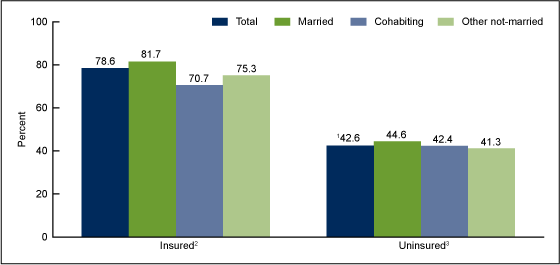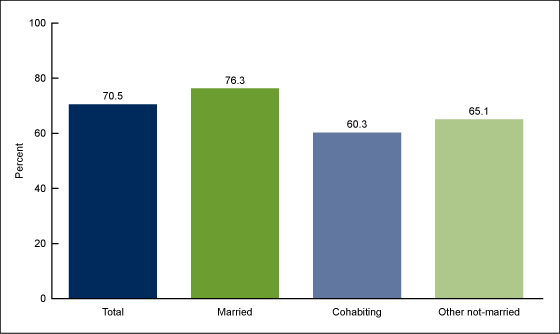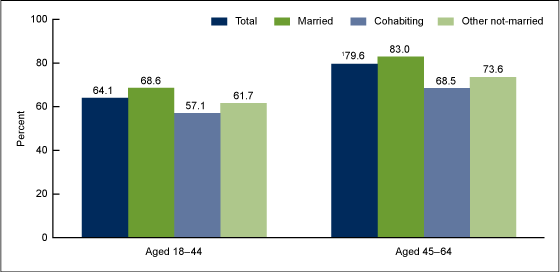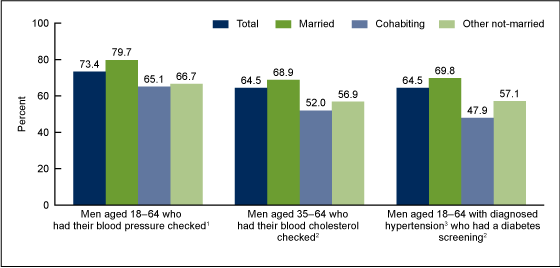Marriage, Cohabitation, and Men's Use of Preventive Health Care Services
NCHS Data Brief No. 154, June 2014
On This Page
- Key findings
- Married men were more likely than cohabiting men and other not-married men to have had a health care visit in the past 12 months.
- Regardless of age, married men were more likely than cohabiting men and other not-married men to have had a health care visit in the past 12 months.
- Married men were more likely than cohabiting men and other not-married men to have had a health care visit in the past 12 months only if they were insured.
- Married men were more likely than cohabiting men and other not-married men to have received recommended clinical preventive services in the past 12 months.
- Summary
- Definitions
- Data source and methods
- About the authors
- References
- Suggested citation
PDF Version (361KB)
Stephen J. Blumberg, Ph.D.; Anjel Vahratian, Ph.D., M.P.H.; and Joseph H. Blumberg, M.S.
Key findings
Data from the National Health Interview Survey, 2011–2012
- Among men aged 18–64, those who were married were more likely than cohabiting men and other not-married men to have had a health care visit in the past 12 months.
- Marriage was associated with greater likelihood of a health care visit for both younger and older men, and for men with health insurance.
- Among those for whom blood pressure, cholesterol, and diabetes screenings are recommended by the U.S. Preventive Services Task Force, married men were more likely than cohabiting men to have received these clinical preventive services in the past 12 months.
- Cohabiting men were less likely than other not-married men to have had a health care visit, cholesterol check, or diabetes screening.
Previous research has demonstrated that married men are more likely than not-married men to seek preventive health care services because their spouses encourage them to do so (1,2). It was not known, however, whether cohabiting partners of not-married men play a health-promoting role similar to that of spouses. With data from the 2011–2012 National Health Interview Survey (NHIS), selected measures of preventive health care service use were compared for three groups of men aged 18–64: married men (defined as those living with a spouse), cohabiting men (defined as those living with a partner who is not a spouse), and other not-married men. The consistency of observed differences by age and health insurance coverage status was also investigated.
Keywords: men's health, health care utilization, doctor visits, screening
Married men were more likely than cohabiting men and other not-married men to have had a health care visit in the past 12 months.
Figure 1. Percentage of men aged 18–64 with at least one health care visit in past 12 months, by marital status: United States, 2011–2012
NOTE: Estimates for the three groups of men were significantly different from each other.
SOURCE: CDC/NCHS, National Health Interview Survey, 2011–2012.
Marriage and cohabitation were related to men's use of health care. Among men aged 18–64, those who were married (76.3%) were more likely than cohabiting men (60.3%) and other not-married men (65.1%) to have had a health care visit within the past year. Cohabiting men were less likely than other not-married men to have had a health care visit within the past year (Figure 1).
Regardless of age, married men were more likely than cohabiting men and other not-married men to have had a health care visit in the past 12 months.
Men aged 45–64 (79.6%) were more likely than men aged 18–44 (64.1%) to have had a health care visit in the past 12 months. However, the association of marriage and cohabitation with men's use of health care was generally consistent regardless of age. Among both age groups, men who were married were more likely than cohabiting men and other not-married men to have had a health care visit within the past year. Cohabiting men were less likely than other not-married men to have had a health care visit within the past year (Figure 2).
Figure 2. Percentage of men aged 18–64 who had at least one health care visit in past 12 months, by age and marital status: United States, 2011–2012
1Significantly different from men aged 18–44.
NOTE: Within each age group, estimates for the three groups of men were significantly different from each other.
SOURCE: CDC/NCHS, National Health Interview Survey, 2011–2012.
Married men were more likely than cohabiting men and other not-married men to have had a health care visit in the past 12 months only if they were insured.
Among men aged 18–64, those with health insurance coverage (78.6%) were more likely than those without coverage (42.6%) to have had a health care visit within the past 12 months. The association of marriage and cohabitation with men's use of health care was observed only for insured men. For insured men, marriage was associated with higher likelihood of a health care visit, and cohabitation was associated with lower likelihood of a health care visit. For uninsured men, neither marriage nor cohabitation was associated with having had a health care visit (Figure 3).
Figure 3. Percentage of men aged 18–64 who had at least one health care visit in past 12 months, by health insurance coverage and marital status: United States, 2011–2012
1Significantly different from insured men.
2Estimates for the three groups of men were significantly different from each other.
3None of the estimates for the three groups of men were significantly different from each other.
SOURCE: CDC/NCHS, National Health Interview Survey, 2011–2012.
Married men were more likely than cohabiting men and other not-married men to have received recommended clinical preventive services in the past 12 months.
The U.S. Preventive Services Task Force recommends that, on a regular basis, all adults have their blood pressure checked, men aged 35 and over have their blood cholesterol checked, and adults with hypertension be screened for type 2 diabetes (3). Marriage and cohabitation were both related to men's receipt of these clinical preventive services. Among men for whom the service was recommended, receipt of each service was more likely for those who were married than for those who were cohabitating or not married. Cholesterol and diabetes screenings were less likely for cohabiting men than for other not-married men (Figure 4).
Figure 4. Percentage of men who received selected clinical preventive services in past 12 months, by marital status: United States, 2011–2012
1Estimates for married men were significantly different from estimates for the other two groups.
2Estimates for the three groups of men were significantly different from each other.
3Defined as having been told they had hypertension by a doctor or other health professional on two or more visits.
SOURCE: CDC/NCHS, National Health Interview Survey, 2011–2012.
Summary
Married men were more likely than not-married men to have had a health care visit within the past 12 months. This association was observed for both younger and older men, but only among men with health insurance. When men have the means to access health care, spouses may play a role in their use of health care by directly encouraging men to seek preventive care and by indirectly evoking in men a sense of economic and social obligation to the family (1,2).
The results suggest that cohabiting partners do not play a similar health-promoting role. Compared with both married men and other not-married men, cohabiting men were less likely to have had a health care visit. They were also less likely to have had selected clinical preventive services in the past 12 months, including blood pressure checks and screenings for elevated cholesterol and diabetes. In fact, cohabiting men are a group particularly at risk of not receiving clinical preventive services recommended by the U.S. Preventive Services Task Force. Only about one-half of men in this group for whom cholesterol and diabetes screenings are recommended had received these screenings in the past 12 months.
Definitions
Blood pressure screening: Based on responses to the survey question, "During the past 12 months, have you had your blood pressure checked by a doctor, nurse, or other health professional?"
Cholesterol screening: Based on responses to the survey question, "During the past 12 months, have you had your blood cholesterol checked by a doctor, nurse, or other health professional?"
Diabetes screening: Based on responses to the survey question, "Have you had a fasting test for high blood sugar or diabetes during the past 12 months?"
Health care visit: Based on responses to the survey question, "During the past 12 months, how many times have you seen a doctor or other health care professional about your own health at a doctor's office, a clinic, or some other place? Do not include times you were hospitalized overnight, visits to hospital emergency rooms, home visits, dental visits, or telephone calls."
Health insurance status: Insured men include those who, at the time of interview, had any private health insurance, Medicare, Medicaid, Children's Health Insurance Program, state-sponsored or other government-sponsored health plan, or military plan. Men were defined as uninsured if they did not have any of these coverage types, had only Indian Health Service coverage, or had only a private plan that paid for one type of service, such as accidents or dental care.
Hypertension: To be classified with diagnosed hypertension, also called high blood pressure, respondents had to report that they had been told by a doctor or other health professional that they had hypertension on two or more different visits.
Marital status: Not-married men include those reported to be widowed, divorced, separated, or never married. Cohabiting men are those reported to be living with a partner. For men identified as married, a separate survey question asked if their spouse was living in the household. Married men whose spouse was not in the household and men with unknown marital status were excluded from all analyses. Spouses and partners may be of any gender and age.
Data source and methods
NHIS is a multipurpose health survey conducted continuously throughout the year by the Centers for Disease Control and Prevention's (CDC) National Center for Health Statistics (NCHS). Interviews are conducted in respondents' homes, but follow-ups to complete interviews may be conducted over the telephone. One knowledgeable person from each family answered questions about each family member, including age, marital status, and health insurance coverage. One randomly selected "sample adult" from each interviewed family answered questions about himself or herself, including health care use. Active-duty Armed Forces personnel were not eligible to be selected as the sample adult, but they were included when determining marital status. For further information about NHIS, visit the NHIS website.
Analyses in this report were based on NHIS data collected in 2011 or 2012 from 24,310 sample adult men aged 18–64. Analyses were limited to sample adults under age 65 because nearly all adults aged 65 and over have had a health care visit in the past 12 months (4). Sampling weights were used to produce national estimates that are representative of the civilian noninstitutionalized U.S. population (5). Point estimates and statistical tests were calculated using SUDAAN software (version 11.0; RTI International, Research Triangle Park, N.C.) to account for the complex sample design of NHIS. All estimates shown in this report have a relative standard error (RSE) less than 7.7% and meet the NCHS standard for reliability (RSE of 30% or less). All comparisons were evaluated for statistical significance at the 0.05 level using two-sided tests.
About the authors
Stephen Blumberg and Anjel Vahratian are with CDC/NCHS, Division of Health Interview Statistics. Joseph Blumberg is Executive Director of the Men's Health and Wellness Center, Inc., in Atlanta, GA.
References
- Norcross WA, Ramirez C, Palinkas LA. The influence of women on the health care-seeking behavior of men. J Fam Pract 43(5):475–80. 1996.
- Stimpson JP, Wilson FA. Cholesterol screening by marital status and sex in the United States. Prev Chronic Dis 6(2):A55. 2009.
- U.S. Preventive Services Task Force. USPSTF A and B recommendations. 2014.
- Blackwell DL, Lucas JW, Clarke TC. Summary health statistics for U.S. adults: National Health Interview Survey, 2012. National Center for Health Statistics. Vital Health Stat 10(260). 2014.
- Parsons VL, Moriarity C, Jonas K, et al. Design and estimation for the National Health Interview Survey, 2006–2015. National Center for Health Statistics. Vital Health Stat 2(165). 2014.
Suggested citation
Blumberg SJ, Vahratian A, Blumberg JH. Marriage, cohabitation, and men's use of preventive health care services. NCHS data brief, no 154. Hyattsville, MD: National Center for Health Statistics. 2014.
Copyright information
All material appearing in this report is in the public domain and may be reproduced or copied without permission; citation as to source, however, is appreciated.
National Center for Health Statistics
Charles J. Rothwell, M.S., M.B.A., Director
Jennifer H. Madans, Ph.D., Associate Director for Science
Division of Health Interview Statistics
Jane F. Gentleman, Ph.D., Director
- Page last reviewed: November 6, 2015
- Page last updated: June 11, 2014
- Content source:


 ShareCompartir
ShareCompartir


